Learn how to install Couchbase Server on CentOS 8 with our comprehensive guide. Follow step-by-step instructions to set up and configure Couchbase for optimal performance on your Linux system. #centlinux #linux #nosql
Table of Contents
What is Couchbase?
Couchbase is a distributed, NoSQL, document-oriented database management system that is designed for interactive applications. It combines the flexibility of JSON data modeling with a distributed architecture for performance, scalability, and high availability. Here are some key points about Couchbase:
- NoSQL Database: Couchbase is classified as a NoSQL database because it does not rely on the traditional relational database model. Instead, it stores data in a flexible JSON format, allowing for dynamic schemas and easier integration with modern application development practices.
- Key-Value Store and Document Database: It functions as both a key-value store and a document database. Data is stored as JSON documents, which can be queried using SQL-like language (N1QL) or accessed directly via key-value operations.
- Distributed Architecture: Couchbase employs a distributed architecture with built-in replication, sharding, and automatic failover capabilities. This enables horizontal scaling across multiple nodes to handle large volumes of data and high request rates.
- High Performance: It is designed to deliver high performance with low latency, capable of handling thousands to millions of operations per second depending on the deployment configuration.
- Built-in Caching: Couchbase includes an integrated caching layer that leverages memory-optimized storage for frequently accessed data. This enhances read and write performance by reducing disk I/O.
- Multi-Cluster Global Replication: Supports cross-datacenter replication (XDCR) for creating geographically distributed clusters, ensuring data consistency and disaster recovery.
- Use Cases: Couchbase is used in various applications such as real-time analytics, content management, user profile management, recommendation engines, and IoT data management where flexibility, scalability, and performance are critical.
Overall, Couchbase provides a scalable and flexible database solution for modern applications that require fast access to large volumes of diverse data types.

Couchbase vs MongoDB
Couchbase and MongoDB are both popular NoSQL databases, each with its own strengths and features. Here’s a comparison between the two:
Couchbase
Data Model:
- Document-Oriented: Stores data in JSON format as documents, allowing for flexible schemas and easy handling of complex data structures.
- Key-Value Store: Supports key-value operations alongside document storage.
Architecture:
- Distributed: Designed with a distributed architecture for scalability and high availability.
- Built-in Caching: Includes an integrated caching layer to optimize performance by reducing disk I/O through memory-optimized storage.
Query Language:
- N1QL: Uses SQL-like language (N1QL) for querying JSON data, providing a familiar interface for developers.
Use Cases:
- Real-Time Applications: Suitable for applications requiring low-latency data access and high throughput.
- Scalability: Well-suited for horizontally scaling across multiple nodes to handle large volumes of data and concurrent requests.
MongoDB
Data Model:
- Document-Oriented: Stores data in BSON (Binary JSON) format as documents, offering flexibility in data modeling.
- Rich Query Language: Supports a powerful query language for CRUD operations and aggregation framework for data analysis.
Architecture:
- Distributed: Supports horizontal scaling through sharding, enabling linear scalability across clusters.
- Replication: Provides built-in replication for high availability and disaster recovery.
Features:
- Indexes: Offers flexible indexing options to optimize query performance.
- Transactions: Supports multi-document ACID transactions in a distributed environment (starting from version 4.0).
Use Cases:
- General-Purpose Database: Used in a wide range of applications including content management, mobile apps, and analytics.
- Complex Querying: Ideal for applications requiring complex querying and data analysis.
Summary
- Couchbase emphasizes performance, scalability, and flexibility with its integrated caching and SQL-like querying.
- MongoDB offers rich query capabilities, strong consistency through transactions, and a mature ecosystem for various application needs.
Choosing between Couchbase and MongoDB depends on specific project requirements, such as performance needs, data structure complexity, and scalability demands. Both databases excel in different areas, catering to diverse use cases in modern application development.
Master MongoDB with The Complete Developer’s Guide 2025 and take your database skills to the next level with real-world projects.

Environment Specification
We are using a minimal CentOS 8 virtual machine with following specifications.
- CPU – 3.4 Ghz (1 cores)
- Memory – 3 GB
- Storage – 20 GB
- Operating System – CentOS 8.2
- Hostname – couchbase-01.centlinux.com
- IP Address – 192.168.116.206 /24
PDF Reader for Fire Tablet
$2.99 (as of September 17, 2025 18:08 GMT +00:00 – More infoProduct prices and availability are accurate as of the date/time indicated and are subject to change. Any price and availability information displayed on [relevant Amazon Site(s), as applicable] at the time of purchase will apply to the purchase of this product.)Read Also: How to install CockroachDB Cluster on CentOS 8
Update your Linux Server
Use a SSH client and connect with couchbase-01.centlinux.com as root user.
As per best practice, we always recommend to update the existing software packages on CentOS 8 operating system, and then install any new software on that server.
Execute dnf command to update existing software packages on CentOS 8.
dnf update -yOutput:
Last metadata expiration check: 0:00:20 ago on Sun 06 Sep 2020 07:39:54 PM PKT.
Dependencies resolved.
Nothing to do.
Complete!
Our Linux operating system is already up-to-date, so there is nothing to update right now. The output may vary on your server machine.
Disable Transparent HugePages
Transparent HugePages are enabled by default in CentOS 8. But it harms the performance of Couchbase database.
Therefore, it is required that, you should disable Transparent HugePages on your Linux operating system before installing the NoSQL database server.
Check the current status of Transparent HugePages.
cat /sys/kernel/mm/transparent_hugepage/enabledOutput:
[always] madvise never
As expected, Transparent HugePages are already enabled in our Linux operating system.
To disable Transparent HugePages, you have to edit GRUB boot menu. For this purpose, edit the GRUB configuration file in vim text editor.
vi /etc/default/grubLocate GRUB_CMDLINE_LINUX and append “transparent_hugepage=never” at the end of line.
GRUB_CMDLINE_LINUX="resume=/dev/mapper/cl-swap rd.lvm.lv=cl/root rd.lvm.lv=cl/swap rhgb quiet transparent_hugepage=never"Generate new GRUB boot menu based on customized configuration file.
grub2-mkconfig -o /boot/grub2/grub.cfgOutput:
Generating grub configuration file ...
done
Restart Linux operating system to apply new settings.
systemctl rebootAfter restart, check the status of HugePages again.
cat /sys/kernel/mm/transparent_hugepage/enabledOutput:
always madvise [never]
You have disabled Transparent HugePages on your Linux operating system. But you are also required to configure tuned service as well.
tuned service is used for monitoring and tuning in a Linux system. tuned service can be used to disable or enable Transparent HugePages.
Therefore, we need to create a profile for tuned service and disable the Transparent HugePages in that profile.
Create a directory for new tuned profile.
mkdir /etc/tuned/no-thpCreate a tuned configuration file.
vi /etc/tuned/no-thp/tuned.confAdd following lines in that file.
[main]
include=virtual-guest
[vm]
transparent_hugepages=never Enable the no-thp profile by using following command.
tuned-adm profile no-thpFUJIFILM Instax Mini Instant Film Twin Pack (White), 20 Photos
$16.99 (as of September 17, 2025 15:49 GMT +00:00 – More infoProduct prices and availability are accurate as of the date/time indicated and are subject to change. Any price and availability information displayed on [relevant Amazon Site(s), as applicable] at the time of purchase will apply to the purchase of this product.)Change Swappiness in CentOS 8
The Linux kernel’s swappiness setting defines how aggressively it will swap memory pages versus dropping pages from the page cache.
A higher value increases swap aggressiveness, while a lower value tells the Linux kernel to swap as little as possible to disk and favor RAM.
The swappiness range is from 0 to 100, and most Linux distributions have swappiness set to 60 by default.
Couchbase Database Server is optimized with its managed cache to use RAM, and is capable of managing what should be in RAM and what shouldn’t be. Allowing the Linux operating system to have too much control over what memory pages are in RAM is likely to lower your NoSQL database performance. Therefore, it’s recommended that swappiness should be set to 0.
Check current setting of swappiness.
cat /proc/sys/vm/swappinessOutput:
60
Set the swappiness setting to 0 for the running system.
sysctl -w vm.swappiness=0Output:
vm.swappiness = 0
Verify the current setting of swappiness again.
cat /proc/sys/vm/swappinessOutput:
0
To make swappiness setting persistent, we have to add it in Kernel parameter file.
echo 'vm.swappiness=0' >> /etc/sysctl.d/99-swappiness.confInstall Couchbase Yum Repository
Couchbase software is provided through their official yum repository.
Therefore, you are required to install Couchbase yum repository first on your Linux operating system.
dnf install -y https://packages.couchbase.com/releases/couchbase-release/couchbase-release-1.0-x86_64.rpmBuild cache for newly installed yum repositories.
dnf makecacheOutput:
CentOS-8 - AppStream 7.3 kB/s | 4.3 kB 00:00
CentOS-8 - Base 6.2 kB/s | 3.9 kB 00:00
CentOS-8 - Extras 3.7 kB/s | 1.5 kB 00:00
Couchbase Server 52 kB/s | 119 kB 00:02
Couchbase Server (Community Edition) 29 kB/s | 106 kB 00:03
Couchbase SDK package repository 8.2 kB/s | 6.7 kB 00:00
Metadata cache created.
Install Couchbase Server on CentOS 8
You have already added required yum repository, therefore, you can now easily install Couchbase on CentOS 8 server by using dnf command.
dnf install -y couchbase-serverYou have learned to install Couchbase on CentOS 8.
Set Process & File Descriptors Limits
The default process and file descriptor limits are not sufficient for couchbase user. Therefore, you have to explicitly increase these limits.
Create a configuration file in /etc/security/limits.d directory by using vim text editor.
vi /etc/security/limits.d/couchbase.confAnd add following settings therein.
couchbase soft nproc 10000
couchbase hard nproc 10000
couchbase soft nofile 70000
couchbase hard nofile 70000Configure Linux Firewall
Couchbase database uses following service ports.
- 8091/18091 – Cluster Administration Console (HTTP/HTTPS)
- 8092/18092 – Views and XDCR Access (HTTP/HTTPS)
- 8093/18093 – Query Service (HTTP/HTTPS)
- 8094/18094 – Search Service (HTTP/HTTPS)
- 8095/18095 – Analytics Service (HTTP/HTTPS)
- 8096/18096 – Eventing Service (HTTP/HTTPS)
- 9140 – Eventing Service Debugger
- 11210,11211,11207 – Data Service
Therefore, you need to allow incoming traffic to these ports, to make them accessible across the network.
firewall-cmd --permanent --add-port={8091-8096,9140,11210,11211,11207,18091-18096}/tcp
firewall-cmd --reloadConfiguring Couchbase Server
Open URL http://couchbase-01.centlinux.com:8091 in a web browser.
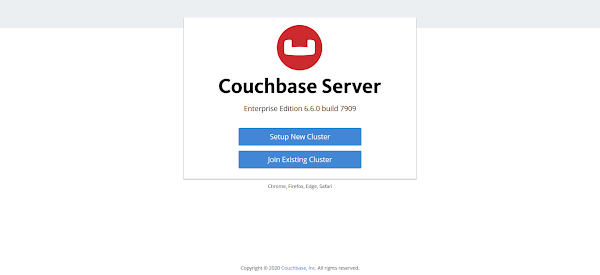
Since, you are accessing Couchbase web console for the first time, therefore, you are being asked to setup this cluster node.
If you are already running a Couchbase cluster, then you can add this node to your existing cluster.
Because you don’t have any Couchbase cluster, therefore, you have to create a new cluster.
Click on ‘Setup New Cluster’.
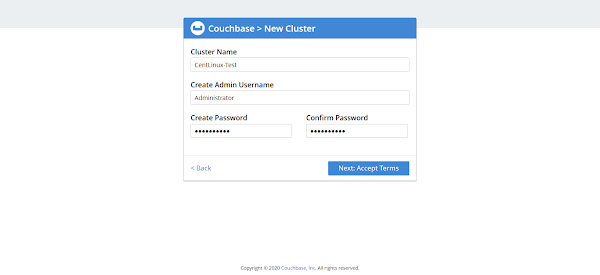
Provide information to create a new cluster and click on ‘Next: Accept Terms’.
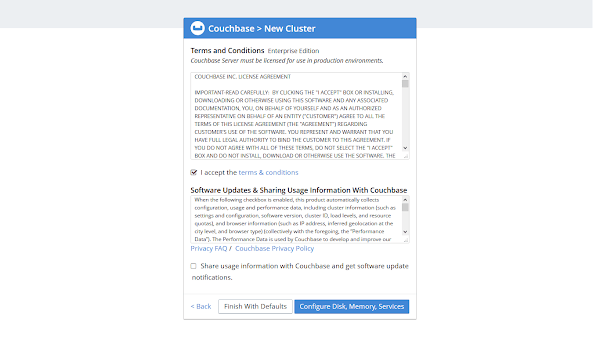
Read and accept the license agreement and click on ‘Configure Disk, Memory, Services’.
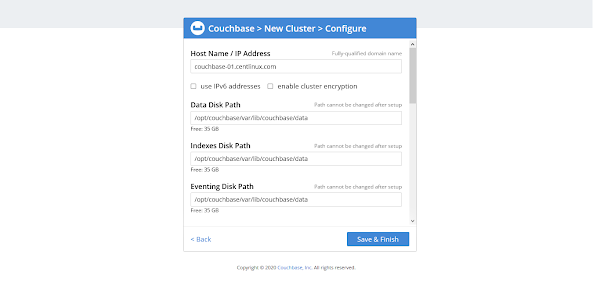
Change settings here according to your requirement. Don’t worry, you can also change these settings later from the web interface.
Click on ‘Save & Finish’.
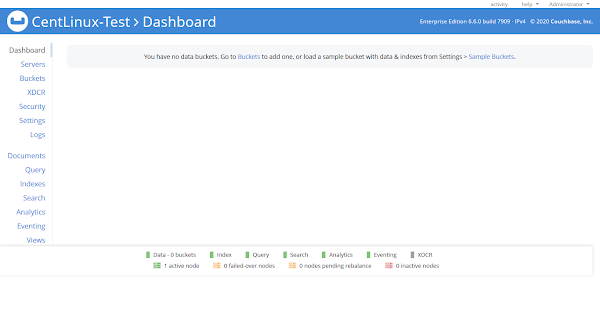
You will be redirected to the Dashboard. It is currently empty, because there isn’t any bucket created yet.
Click on ‘Settings > Sample Buckets’.
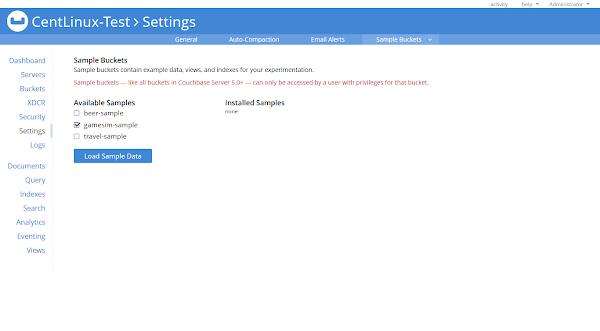
Choose a sample and click on ‘Load Sample Data’.
Go back to Dashboard again.
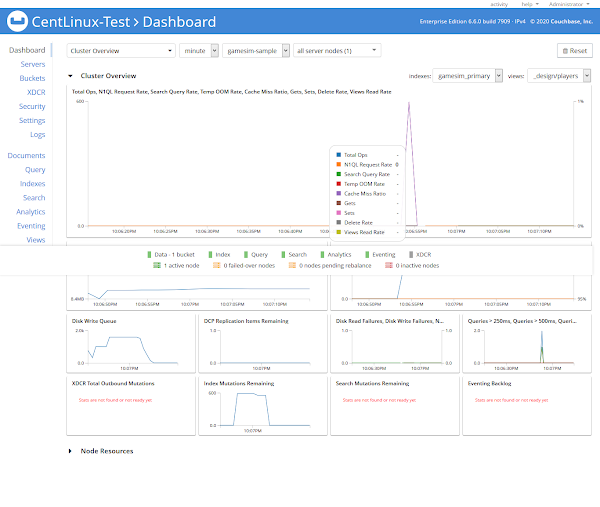
Now, you can see some graphs based on the sample data.
Amazon Kindle Paperwhite 16GB (newest model) – Our fastest Kindle ever, with new 7″ glare-free display and weeks of battery life – Black
$159.99 (as of September 18, 2025 08:18 GMT +00:00 – More infoProduct prices and availability are accurate as of the date/time indicated and are subject to change. Any price and availability information displayed on [relevant Amazon Site(s), as applicable] at the time of purchase will apply to the purchase of this product.)Final Thoughts
Setting up Couchbase Server on CentOS 8 opens up powerful possibilities for scalable, high-performance data management in your applications. With its flexible JSON data model and distributed architecture, Couchbase is an excellent choice for projects requiring real-time analytics, content management, and more.
From setting up scalable AWS solutions to managing complex Linux environments, I’ve got you covered. Visit my Freelancer profile to get started.
Let’s get your Couchbase deployment up and running efficiently!




Leave a Reply
Please log in to post a comment.